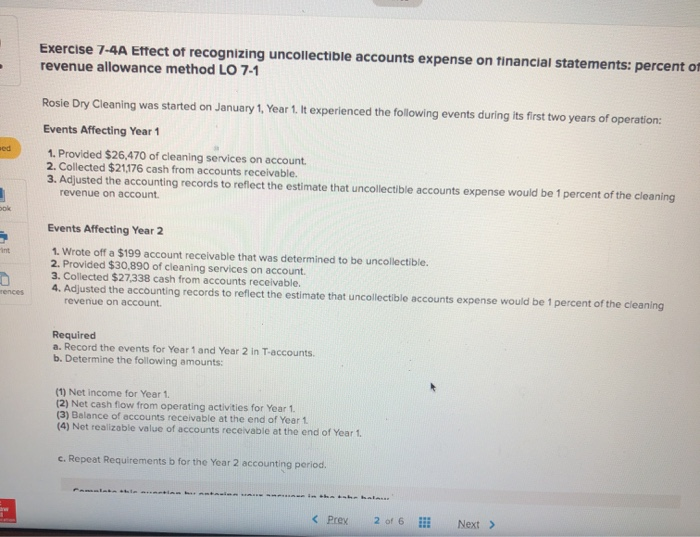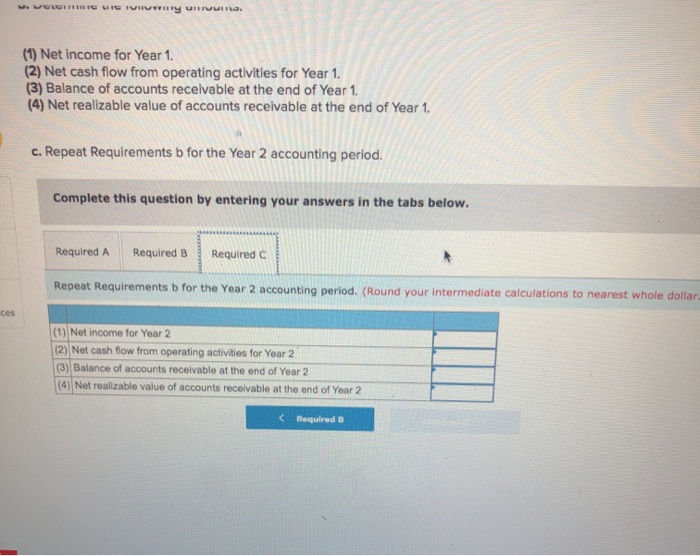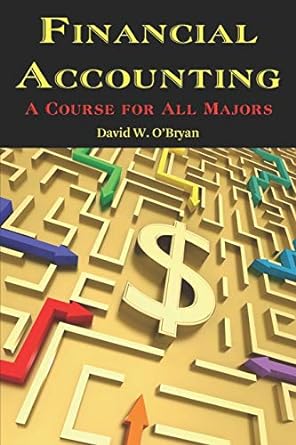Exercise 7-4A Effect of recognizing uncollectible accounts expense on financial statements: percent of revenue allowance method LO 7-1 Rosie Dry Cleaning was started on January 1, Year 1. It experienced the following events during its first two years of operation: Events Affecting Year 1 1. Provided $26,470 of cleaning services on account. 2. Collected $21,176 cash from accounts receivable. 3. Adjusted the accounting records to reflect the estimate that uncollectible accounts expense would be 1 percent of the cleaning revenue on account. Events Affecting Year 2 1. Wrote off a $199 account receivable that was determined to be uncollectible. 2. Provided $30,890 of cleaning services on account. 3. Collected $27,338 cash from accounts receivable. 4. Adjusted the accounting records to reflect the estimate that uncollectible accounts expense would be 1 percent of the cleaning revenue on account. Required a. Record the events for Year 1 and Year 2 in T-accounts b. Determine the following amounts: (1) Net Income for Year 1 (2) Net cash flow from operating activities for Year 1. (3) Balance of accounts receivable at the end of Year 1 (4) Net realizable value of accounts receivable at the end of Year 1. c. Repeat Requirements b for the Year 2 accounting period. Retained Earnings Year 1 Beg. Bal. End. Bal Year End Bal Accounts Receivable Service Revenue Year 2 End Bal End. Bal. Allowance for Doubtful Accounts Uncollectible Accounts Expense Year 1 Year 1 VELLE IV IEQI I. (2) Net cash flow from operating activities for Year 1. (3) Balance of accounts receivable at the end of Year 1. (4) Net realizable value of accounts receivable at the end of Year 1. c. Repeat Requirements b for the Year 2 accounting period. Complete this question by entering your answers in the tabs below. Required A Required B Required C Determine the following amounts: (Round your intermediate calculations to nearest whole dollar.) (1) Net income for Year 1. (2) Net cash flow from operating activities for Year 1. (3) Balance of accounts receivable at the end of Year 1. (4) Net realizable value of accounts receivable at the end of Year 1. Show (1) Net income for Year 1 (2) Net cash flow from operating activities for Year 1 (3) Balance of accounts receivable at the end of Year 1 (4) Net realizable value of accounts receivable at the end of Year 1 . WEITE Hwry unuia. (1) Net income for Year 1. (2) Net cash flow from operating activities for Year 1. (3) Balance of accounts receivable at the end of Year 1. (4) Net realizable value of accounts receivable at the end of Year 1. c. Repeat Requirements b for the Year 2 accounting period. Complete this question by entering your answers in the tabs below. Required A Required B Required C Repeat Requirements b for the Year 2 accounting period. (Round your intermediate calculations to nearest whole dollar ces (1) Net income for Year 2 (2) Net cash flow from operating activities for Year 2 (3) Balance of accounts receivable at the end of Year 2 (4) Net realizable value of accounts receivable at the end of Year 2 Retained Earnings Year 1 Beg. Bal. End. Bal Year End Bal Accounts Receivable Service Revenue Year 2 End Bal End. Bal. Allowance for Doubtful Accounts Uncollectible Accounts Expense Year 1 Year 1 VELLE IV IEQI I. (2) Net cash flow from operating activities for Year 1. (3) Balance of accounts receivable at the end of Year 1. (4) Net realizable value of accounts receivable at the end of Year 1. c. Repeat Requirements b for the Year 2 accounting period. Complete this question by entering your answers in the tabs below. Required A Required B Required C Determine the following amounts: (Round your intermediate calculations to nearest whole dollar.) (1) Net income for Year 1. (2) Net cash flow from operating activities for Year 1. (3) Balance of accounts receivable at the end of Year 1. (4) Net realizable value of accounts receivable at the end of Year 1. Show (1) Net income for Year 1 (2) Net cash flow from operating activities for Year 1 (3) Balance of accounts receivable at the end of Year 1 (4) Net realizable value of accounts receivable at the end of Year 1 . WEITE Hwry unuia. (1) Net income for Year 1. (2) Net cash flow from operating activities for Year 1. (3) Balance of accounts receivable at the end of Year 1. (4) Net realizable value of accounts receivable at the end of Year 1. c. Repeat Requirements b for the Year 2 accounting period. Complete this question by entering your answers in the tabs below. Required A Required B Required C Repeat Requirements b for the Year 2 accounting period. (Round your intermediate calculations to nearest whole dollar ces (1) Net income for Year 2 (2) Net cash flow from operating activities for Year 2 (3) Balance of accounts receivable at the end of Year 2 (4) Net realizable value of accounts receivable at the end of Year 2










